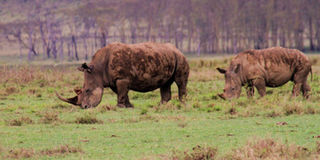Nakuru National Park: Of fees, floods and flamingos

PHOTO | JOHN FOX Browsing the short grass were two rhinos – and then seven more before we reached the lake shore.
From the Mbweha Camp near the Nderit Gate, we went into the Nakuru National Park. But we had to drive right into the busy, congested town and then to the park’s main gate, because I didn’t have enough credit on my KWS Safari Card and they couldn’t take money at the Nderit Gate.
And this gives me a chance to work off some of the irritation I often, if not always, feel about the KWS fee-charging system whenever I visit one of our national parks. I once met the guy who had carried out the “ability-to-pay” survey that led to the smartcard system; I told him he should also have made a “willingness-to-pay” survey because I reckon many people are put off.
But it’s not so much the high prices — whether for non-residents, residents or citizens — but the complexity of the smartcard system that seems to confuse even those who are administering it, as well as frustrating patrons. It took us about 30 minutes to get through the gates. There were only four of us. We paid at one office and, despite our repeated queries, we were given the wrong number of temporary passes. So when we got to the actual gate kiosk for deducting the fee on the Safari Card we had to go back for the missing temporary card.
It is about as cumbersome as the process of getting into the United Nations complex at Gigiri — and just as likely to put you in a bad mood. Surely there are simpler ways of checking on corrupt cashiers and officials.
But, having got that complaint out of the way, let me talk about the park, its animals and birds.
Plenty of animals
The Nakuru National Park is one of the gems of the parks. It is small enough to traverse quite easily in a half-day visit, but large enough to contain plenty of animals — a variety of them because there is a mix of woodland in the north and plains in the south. Then, of course, there is the lake itself — famed for its flamingos.
There were only a few flamingos there a couple of weeks ago, dredging the fringes of the southern shore of the lake. Gone are the days, it seems, when flamingos massed on the lake in numbers over a million. Now, you are more likely to see them in their hundreds rather than thousands.
There has been a lot of debate over recent years as to the cause of their decline. Some point to the rise in the water level — the level has gone dramatically up and down over the years — and the consequent reduction in the lake’s salinity. Others point to the pollution from the industrialisation of the rapidly growing Nakuru town.
Water birds
Fortunately, there are always some flamingos there — and the larger flocks do still come in, even if sporadically. Also, the lake is home to flotillas of pelicans and many other species of water birds.
The rain had eased off when we eventually negotiated the gates, but the wind was churning the waters as fiercely as I have ever seen there. We were surprised to see how the lake had risen and flooded into the forest of the north-eastern shoreline.
The rain did us a good turn. Not far along the eastern track we came across some lions drinking at a roadside puddle – two thirsty females and four very frisky cubs. There were lots of waterbuck on the drier ground under the trees – and small herds of impala higher up the slopes.
Once through the woods we caught sight of the flamingos, so we turned to the right across the flatland and back towards the lake. Browsing the short grass there were two rhinos — and then seven more before we reached the lake shore. There were a number of tourist vehicles parked near the flamingos, and their occupants had walked out across the mudflats to get closer photographs. There was a flock of sacred ibises, isolated herons and many less easily identified waders – all perhaps somewhat disgruntled that the cameras were not focused on them.
There was a slight chill in the early evening air, so before leaving the park through the Nderit Gate, we called at the Lake Nakuru Lodge for hot pots of tea. Developed from an old Delamere Estate house, this is the older of the two main lodges in the Park. (The other is the Sarova Lion Hill Game Lodge set on the eastern slopes and high above the lake.)
The Lake Nakuru Lodge has over 100 rooms, a large swimming pool, and a dining room, bar and terraces with a splendid view across the grassland and to the lake. But that day, it was as if we four had the lodge to ourselves – perhaps there were still a number of guests out on their game drives.
Whatever – with its lake and woodlands, its animals and birds, its lodges and camp sites, Lake Nakuru National Park, only two hours’ drive from the outskirts of Nairobi, makes for a very attractive place for a weekend away.
When you go...
Park fees
Adults:
Citizens: Sh1,000/-
Residents: Sh1,000/-
Non-Residents: $80
Children:
Citizen: Sh200/-
Resident: Sh500
Non-Residents: $40
John Fox is Managing Director iDC




